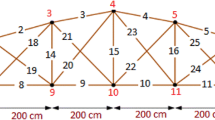Abstract
Vibration-based structural health monitoring aims to not only detect the occurrence of the damage but also identify the location of damage. The pseudo-local flexibility method (PLFM) is a vibration-based approach that only requires the identified modal parameters of the structure to perform damage detection. Thus, the cost of constructing a finite-element model of the structure and the modeling error of the finite-element model can be circumvented. In addition, the PLFM is based on the flexibility matrix of the structure, which is practical, because only the first few modes are required to estimate the necessary flexibility matrix and only the first few modes can be identified accurately in real applications. However, the potential damage region that is identified using the PLFM is indicated by the location of the center of the applied virtual forces, but not the potential damage elements. Hence, in this study, an enhanced PLFM (EPLFM) is proposed to improve the resolution of damage localization in the conventional PLFM. The regional rigidity ratios obtained by the PLFM are distributed to each element based on the virtual strain energy corresponding to virtual forces. The damage locations indicated by the EPLFM are marked at each element, and hence, more specific damage locations can be identified by the elements with smaller elemental rigidity ratios. Herein, the present EPLFM was numerically and experimentally validated with a simply supported steel-truss bridge. In the numerical validation, a simplified two-dimensional finite-element model for the truss structure was constructed using SAP2000 software package, and seven damage scenarios and two setups of measurement degrees of freedom (DOF) were investigated. It is found that accurate damage localization of the 2D simply supported truss structure was achieved when both the vertical and horizontal DOFs of all nodes were measured and the virtual force configurations acting on both ends of each element were used. In the in-field experimental validation where the mode-truncation errors and measurement noises were unavoidably introduced, it was observed that the EPLFM could identify the full-cut vertical member at the mid-span or 5/8th span, even though the cut member was identified in a group with some adjacent un-damaged members.























Similar content being viewed by others
References
Toksoy T, Aktan AE (1994) Bridge-condition assessment by modal flexibility. Exp Mech 34:271–278. https://doi.org/10.1007/BF02319765
Bernal D (2002) Load Vectors for Damage Localization. J Eng Mech 128:7–14. https://doi.org/10.1061/(ASCE)0733-9399(2002)128:1(7)
Reynders E, De Roeck G (2010) A Local Flexibility Method for Vibration-based Damage Localization and Quantification. J Sound Vib 329:2367–2383. https://doi.org/10.1016/j.jsv.2009.04.026
Hsu TY, Shiao SY, Liao WI (2015) A pseudo local flexibility algorithm for vibration-based damage detection of hyperstatic beams. Struct Control Health Monit 22:682–693. https://doi.org/10.1002/stc.1713
Hsu TY, Liu CL (2018) Damage Detection of a Thin Plate Using Pseudo Local Flexibility Method. Earthq Struct 15:463–471. https://doi.org/10.12989/eas.2018.15.5.463
Van Overschee P, De Moor B (1996) Subspace Identification for Linear Systems: Theory, Implementatio, Applications. Kluwer Academic Publishers, Dordrecht, The Netherlands
GC Lee, SB Mohan, C Huang, BN Fard (2013) A study of US bridge failures (1980–2012). Technical Rep. No. MCEER-13–0008, Univ. at Buffalo, Buffalo, NY.
Kopsaftopoulos FP, Fassois SD (2010) Vibration based health monitoring for a lightweight truss structure: Experimental assessment of several statistical time series methods. Mech Syst Sig Process 24:1977–1997. https://doi.org/10.1016/j.ymssp.2010.05.013
Zhan JW, Xia H, Chen SY, Roeck GD (2011) Structural damage identification for railway bridges based on train-induced bridge responses and sensitivity analysis. J Sound Vib 330:757–770. https://doi.org/10.1016/j.jsv.2010.08.031
Wang L, Chan THT, Thambiratnam DP, Tan ACC, Cowled CJL (2012) Correlation-based damage detection for complicated truss bridges using multi-layer genetic algorithms. Adv Struct Eng 15:693–706. https://doi.org/10.1260/1369-4332.15.5.693
Prajapat K, Chaudhury SR (2017) Damage detection in railway truss bridges employing data sensitivity under Bayesian framework: A numerical investigation. J Shock Vibr 4:1–9. https://doi.org/10.1155/2017/6423039
Goi Y, Kim CW (2017) Damage detection of a truss bridge utilizing a damage indicator from multivariate autoregressive model. J Civil Struct Health Monit 7:153–162. https://doi.org/10.1007/s13349-017-0222-y
Riasat Azim M, Gül M (2020) Damage detection of steel-truss railway bridges using operational vibration data. J Struct Eng 146:04020008. https://doi.org/10.1061/(asce)st.1943-541x.0002547
Mousavi AA, Zhang C, Masri SF, Gholipour G (2021) Structural damage detection method based on the complete ensemble empirical mode decomposition with adaptive noise: a model steel truss bridge case study. Struct Health Monit 21:887–912. https://doi.org/10.1177/14759217211013535
Chang KC, Kim CW (2016) Modal-parameter identification and vibration-based damage detection of a damaged steel truss bridge. Eng Struct 122:156–173. https://doi.org/10.1016/j.engstruct.2016.04.057
Kim CW, Zhang FL, Chang KC, McGetrick PJ, Goi Y (2021) Ambient and Vehicle-Induced Vibration Data of a Steel Truss Bridge Subject to Artificial Damage. J Bridge Eng 26(7):04721002. https://doi.org/10.1061/(ASCE)BE.1943-5592.0001730
Acknowledgements
This research was funded by the Ministry of Science and Technology, Taiwan under Grant No. MOST 111-2221-E-011-021-MY3.
Author information
Authors and Affiliations
Corresponding author
Ethics declarations
Conflict of interest
The authors have no relevant financial or non-financial interests to disclose.
Additional information
Publisher's Note
Springer Nature remains neutral with regard to jurisdictional claims in published maps and institutional affiliations.
Rights and permissions
Springer Nature or its licensor (e.g. a society or other partner) holds exclusive rights to this article under a publishing agreement with the author(s) or other rightsholder(s); author self-archiving of the accepted manuscript version of this article is solely governed by the terms of such publishing agreement and applicable law.
About this article
Cite this article
Hsu, TY., Lu, MC., Yang, IT. et al. Damage detection of truss bridge elements using an enhanced pseudo-local flexibility method. J Civil Struct Health Monit 14, 615–634 (2024). https://doi.org/10.1007/s13349-023-00742-0
Received:
Accepted:
Published:
Issue Date:
DOI: https://doi.org/10.1007/s13349-023-00742-0




